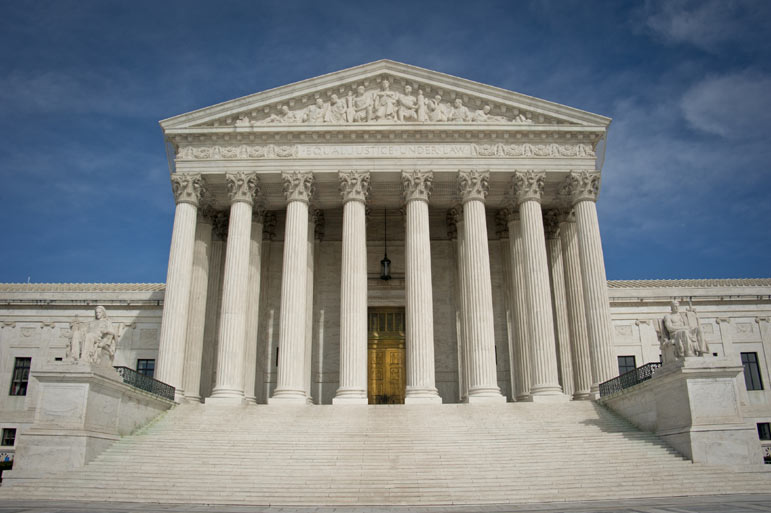
To many, probably most readers, it will seem morally obvious that there should be accountability and liability in a case with such shocking facts. But followers of the court's jurisprudence on qualified immunity — and regular readers of this column — will know that under current law, it's extremely difficult for victims or their families to win cases against police. Indeed, the U.S. Court of Appeals for the Eighth Circuit had dismissed the suit on the ground that the officers were entitled to immunity because they had not violated Gilbert's clearly established constitutional rights.
The Supreme Court decision, reached without the benefit of oral argument or detailed briefing, was 6-3, with an unwritten opinion for the court and a dissent by Justice Samuel Alito that was joined by Justices Clarence Thomas and Neil Gorsuch.
The outcome shows that at least some of the justices read the newspapers and realize how bad it looks for the Supreme Court to allow a lower court opinion like this to remain in place in the era of George Floyd and Black Lives Matter.
The lineup shows the way the current court's conservatives are splitting more and more with each other. Justice Brett Kavanaugh and Amy Coney Barrett, two of President Donald Trump's appointees, have been joining Chief Justice John Roberts and the court's three liberals to reach cautious, moderate decisions.
Meanwhile, the hard-core group of Alito, Thomas and Gorsuch has been arguing for more forthrightly conservative results — regardless of what it means for the court's legitimacy in the light of public opinion.
The legal content of the court's holding was brief and compact. The Eighth Circuit had cited the correct legal test for qualified immunity, the justices held. But the unsigned opinion said that it was "unclear" whether the appeals court had thought that use of a prone restraint was always constitutional if the detained person was resisting officers trying to restrain him.
The justices also told the lower court to review the facts again, taking account of the handcuffs, leg shackles and the 15 minutes for which Gilbert was restrained prone. The opinion noted that the police were subject to guidance to get a suspect "off his stomach" to avoid oxygen deprivation.
It's possible, although not certain, that the lower court will now flip its decision and let the case go forward. That would be good, obviously — but it isn't formally required by the Supreme Court opinion.
In dissent, Alito accused the majority of copping out. The court, he said, should either have let the appeals court ruling stand — and borne "the criticism that would inevitably elicit" — or else taken the case, performed a detailed analysis and decided it on its own.
Alito also said that the majority had willfully misread the appeals court opinion. It was obvious, he said, that the lower court didn't believe that the prone position was necessarily constitutional when a suspect was resisting.
The decision doesn't do much to clarify the state of the law — which is what the Supreme Court usually takes cases to do.
Nor is it exactly an instance of the court engaging in the correction of obvious error made by the lower courts, something the justices rarely do and prefer to avoid. After all, the court avoided saying that the Eight Circuit had definitively got the result wrong.
Rather, this is an unusual decision in which the justices sought to avoid taking the case but also to avoid the outrageous-seeming result. The George Floyd and BLM context clearly mattered.
The fact that Kavanaugh and Barrett thought that way — and Gorsuch didn't — is meaningful data for court watchers. We are all trying to make sense of the Trump appointees' tendencies and jurisprudence. It's highly noteworthy that Kavanaugh and Barrett care about public perception of the court in the light of current events.
The same breakdown was visible recently when Barrett and Kavanaugh declined to overrule precedent and grant religious groups automatic exceptions from neutral, generally applicable laws. Gorsuch voted to do so.
What we are seeing is the emergence of a moderate bloc that, remarkably, includes these two Trump appointees.
Gorsuch, for his part, issued a liberal opinion a year ago in Bostock, the gay and trans anti-discrimination case. But in retrospect, the decision looks a bit more like one in which Gorsuch followed his jurisprudential principles even though they lead somewhere he might not agree with politically. His commitment to ignoring what observers might think about his stance is consistent across that case and subsequent decisions like this.
As for Kavanaugh and Barrett, their caution this term is no guarantee of moderation across the board, to be sure. Abortion, which the court will take up next term, has its own complex politics.
For the moment, however, it's fascinating to see how the justices are framing their decisions in the light of the court's public legitimacy.
(COMMENT, BELOW)
Noah Feldman, a Bloomberg View columnist, is a professor of constitutional and international law at Harvard University and the author of six books, most recently "Cool War: The Future of Global Competition."


 Contact The Editor
Contact The Editor
 Articles By This Author
Articles By This Author